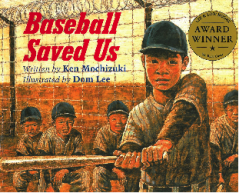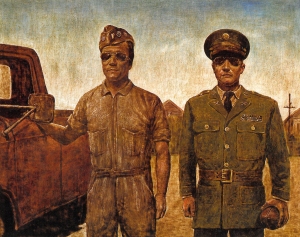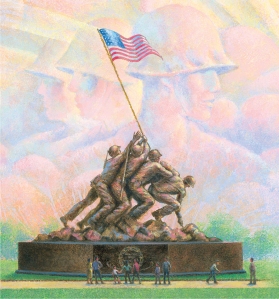new posts in all blogs
Viewing: Blog Posts Tagged with: Ken Mochizuki, Most Recent at Top [Help]
Results 1 - 5 of 5
How to use this Page
You are viewing the most recent posts tagged with the words: Ken Mochizuki in the JacketFlap blog reader. What is a tag? Think of a tag as a keyword or category label. Tags can both help you find posts on JacketFlap.com as well as provide an easy way for you to "remember" and classify posts for later recall. Try adding a tag yourself by clicking "Add a tag" below a post's header. Scroll down through the list of Recent Posts in the left column and click on a post title that sounds interesting. You can view all posts from a specific blog by clicking the Blog name in the right column, or you can click a 'More Posts from this Blog' link in any individual post.

By:
Jaclyn DeForge,
on 12/3/2012
Blog:
The Open Book
(
Login to Add to MyJacketFlap)
JacketFlap tags:
Resources,
Reading Aloud,
Educators,
reading comprehension,
Ken Mochizuki,
close reading,
Baseball Saved Us,
Dom Lee,
common core standards,
slow reading,
Curriculum Corner,
guided reading,
Add a tag
 Jaclyn DeForge, our Resident Literacy Expert, began her career teaching first and second grade in the South Bronx, and went on to become a literacy coach and earn her Masters of Science in Teaching. In her column she offers teaching and literacy tips for educators.
Jaclyn DeForge, our Resident Literacy Expert, began her career teaching first and second grade in the South Bronx, and went on to become a literacy coach and earn her Masters of Science in Teaching. In her column she offers teaching and literacy tips for educators.
Over the past several weeks, I’ve been modeling how to do a close reading at several different grade levels. Next up: Close Reading in Third Grade using the O level text Baseball Saved Us by Ken Mochizuki and illustrated by Dom Lee.
One way to structure close reading questioning is to use the format laid out by the Institute for Learning of the University of Pittsburgh. Under their framework, students read the text selection four times: first, to get the gist; second, to find significant moments or ideas; third, to interpret the ideas in the text; and finally, to analyze the author’s methods (craft). Here’s an example of how to plan out your questions for close reading of just the first 8 pages of Baseball Saved Us:
1st reading (read to get the gist):
- Which characters have we met so far in the story? What do we know about each character so far? Cite evidence from the text to support your answers.
- Where does the story take place? In what country? During what period in history? How do you know? Cite evidence from the text to support your answers.
- How did the characters get to the camp? Why are they there? What is the purpose of the camp? What hardships did the main character’s family face at the camp? How is life at the camp similar to or different from life at home? How does life at the camp affect the people in the story? How do you know? Cite evidence from the text to support your answers.
- Summarize what you have learned about the narrator. How does he see himself? How do others view him? How do you know? Cite evidence from the text to support your answers.
2nd reading (read to find significant moments or ideas):
- What is the most important thing you learned or that happened in this section of the story? Why is it significant? Cite evidence from the text to support your answers.

3rd reading (read to interpret ideas):
- The characters in Baseball Saved Us were Japanese Americans who lived on the West Coast at a time when the United States was fighting a war with Japan. Do you think it was fair for the government to take them from their homes and make them move into an internment camp? Why do you think the government made this decision? Do you agree with the decision? What does it mean to be an American? Do you think the author would agree with you? Do you think the character of Dad would agree with you? Why or why not? Cite evidence from the text to support your answers.
4th reading (read to analyze the author’s methods/craft):
- Based on what you have read so far, how do you think author Ken Mochizuki feels about Japanese internment during World War II? How does he want you to feel about internment camps, specifically about the camp in the story? How do you know? What details does he choose to include in order to influence the reader? Cite evidence from the text to support your answers.
- What is the mood of the story so far? How does illustrator Dom Lee create this mood in his illustrations? Cite evidence from the text to support your answers.
By asking students to ground their responses in the text by citing text-based support for their answers, the following Common Core Standard is addressed:
Reading Literature, Grade 3, Key Ideas and Details, Strand 1: Ask and answer questions to demonstrate understanding of a text, referring explicitly to the text as the basis for the answers.
How does close reading look in your classroom? Any tricks and tips to share?
Further reading:
Filed under:
Curriculum Corner,
Resources Tagged:
Baseball Saved Us,
close reading,
common core standards,
Dom Lee,
Educators,
guided reading,
Ken Mochizuki,
Reading Aloud,
reading comprehension,
slow reading 


image from Heroes
This Sunday is Veterans Day, a national holiday to honor veterans, servicemen and servicewomen who fought or are currently fighting in armed services. Originally named ‘Armstice Day’ on its creation in 1919 by President Wilson, the day was dedicated to “the heroism of those who died in the country’s service” and celebrated the WWI victory which allowed America to bestow peace and justice to other nations. In the aftermath of World War II, which caused the largest mobilization of soldiers, sailors, Marines and airmen in the history of the nation up until that point, and America’s participation in the Korean War, Congress amended the day to be called ‘Veterans Day’ on June 1, 1954. Veterans Day would fall annually on November 11th and be a day to honor American veterans of all wars.

image from Quiet Hero: The Ira Hayes Story
When I was younger, I associated Veterans Day with a day off from school or work and gave the actual veterans little thought. However, Veterans Day is so much more than that. It is a day to celebrate and honor those that have fought for the liberties and rights that we Americans are so lucky to have – including the right to vote, which so many Americans exercised this week. With their service and their lives, the heroes who have fought in wars past or present have given us an invaluable gift that we should take a moment to seriously acknowledge and appreciate. Countless men and women have selflessly given us so much and it’s crucial to not forget that.
To read more about veterans and their honorable and heroic contributions, check out Heroes by Ken Mochizuki and Dom Lee and Quiet Heroes by S.D Nelson.
Filed under:
Holidays Tagged:
Dom Lee,
Heroes,
Ira Hayes,
Ken Mochizuki,
November 11th,
Quiet Hero,
Veteran's Day 


By:
Aline Pereira,
on 12/3/2008
Blog:
PaperTigers
(
Login to Add to MyJacketFlap)
JacketFlap tags:
Young Adult Books,
Uma Krishnaswami,
The Tiger's Bookshelf,
The Tiger's Choice,
Nancy Farmer,
John Boyne,
Minfong Ho,
Katia Novet Saint-Lot,
Julia Alvarez,
Ken Mochizuki,
H Authors,
K Authors,
M Authors,
S Authors,
F Authors,
V Authors,
Jane Vejjajiva,
Children's Books,
Authors,
A Authors,
B Authors,
Add a tag
We have deeply enjoyed hosting the Tiger’s Choice, the PaperTigers’ online bookgroup, over the past year–it introduced us to a number of interesting books, a group of authors whom we hadn’t read before, and a collection of new friends from around the globe who joined in our discussions.
Nancy Farmer, Uma Krishnaswami, Ken Mochizuki, Minfong Ho, Jane Vejjajiva, Julia Alvarez, John Boyne, Katia Novet Saint-Lot are all authors whom we plan to return to again and again for reading that expands our cultural horizons. As their body of work increases, the Tiger’s Bookshelf will be there–to read, to praise, to cheer them on.
We will however be doing this in another form rather than through the Tiger’s Choice. As exciting and rewarding as it has been to explore books through this avenue, we have new plans for the Tiger’s Bookshelf that do not include our bookgroup. We thank all of you who have read this portion of our blog, and who have joined in the discussions, and hope that you will continue to be part of the ongoing conversation that will take place on the PaperTigers Blog, and through the Tiger’s Bookshelf!

By:
Aline Pereira,
on 11/17/2008
Blog:
PaperTigers
(
Login to Add to MyJacketFlap)
JacketFlap tags:
Uncategorized,
Children's Books,
Authors,
Picture Books,
Book Groups,
Heroes,
Illustrators,
The Tiger's Bookshelf,
The Tiger's Choice,
Ken Mochizuki,
B Title,
M Authors,
World War Two,
H Title,
442nd Regimental Combat Team,
Baseball Saved Us,
Dom Lee,
internment camps,
Add a tag

We don’t often think of picture books when we think of book group titles, but this month the Tiger’s Choice offers a picture book. It’s one that is an ideal selection for adults and children to read and discuss together–created by two men, Ken Mochizuki and Dom Lee, who have provided a new defintion of what picture books can be.
Heroes follows their stunning debut, Baseball Saved Us, with a story as powerful and as provocative as that examination of the Japanese internment in the United States during World War Two. This time the story looks at peacetime America, and the difficulty of overcoming the vicious stereotyping that is the collateral damage of war.
One of the most moving and heroic stories from World War Two is the history of the Japanese American men who enlisted in the U.S. Army and formed the 442nd Regimental Combat Team, fighting in Europe and becoming “one of the most highly decorated units in U.S. Army history”–even though many of them had family members confined behind barbed wire fences in desolate internment camps. The strength of these soldiers’ patriotism and the bravery of their military exploits makes my hair stand on end when I read about them–and so does this book.
When Donnie plays war with the other kids, he’s always the enemy because, he’s told, “there wasn’t anybody looking like you on our side.” He knows that isn’t true. He’s heard his father and uncle talk about their time in the Army ; he’s seen their war medals. Yet he’s told, “Real heroes don’t brag” and “You kids should be playing something else besides war.”
But the war games don’t stop–they become more real and more frightening–and Donnie needs help.
Please read this book and add your comments to our final Tiger’s Choice discussion.

By:
Aline Pereira,
on 10/14/2008
Blog:
PaperTigers
(
Login to Add to MyJacketFlap)
JacketFlap tags:
Uncategorized,
Cynthia Kadohata,
Juan Felipe Herrera,
young readers,
John Boyne,
The Boy in the Striped Pajamas,
Beacon Hill Boys,
Cinnamon Girl,
Jamie Bastedo,
Ken Mochizuki,
Kira Kira,
Margaret Wild,
multicultural subjects,
National Reading Group Month,
On Thin Ice,
Woolvs in the Sitee,
C Title,
B Authors,
B Title,
H Authors,
K Authors,
M Authors,
O Title,
W Authors,
W Title,
Children's Books,
Young Adult Books,
Picture Books,
Book Groups,
The Tiger's Bookshelf,
Book Chat,
The Tiger's Choice,
Add a tag
 Since we are already in the middle of National Reading Group Month, our thoughts have turned to reading suggestions for book groups for young readers. At PaperTigers, we are deeply committed to books on multicultural subjects that bring differing cultures closer together. So of course the books on our little list are novels that we think will accomplish that, while they keep their readers enthralled and provide the nourishment for spirited book group discussions. Almost all of the suggested titles are in paperback editions and all should be available in libraries. Most of them have been reviewed by PaperTigers and one has been chosen by our own online bookclub, The Tiger’s Choice.
Since we are already in the middle of National Reading Group Month, our thoughts have turned to reading suggestions for book groups for young readers. At PaperTigers, we are deeply committed to books on multicultural subjects that bring differing cultures closer together. So of course the books on our little list are novels that we think will accomplish that, while they keep their readers enthralled and provide the nourishment for spirited book group discussions. Almost all of the suggested titles are in paperback editions and all should be available in libraries. Most of them have been reviewed by PaperTigers and one has been chosen by our own online bookclub, The Tiger’s Choice.
1. Beacon Hill Boys by Ken Mochizuki (Written for older readers, this novel explores teenage rebellion, parental expectations, and racial stereotypes with humor and perception. This is a perfect book for boys who are reluctant readers–by the end of the first page they’ll be hooked.)
2. On Thin Ice by Jamie Bastedo (Through entries in Ashley’s diary that she keeps while visiting family in an Inuit village, this book addresses the issue of climate change in Arctic Canada, where the polar bears are coming far too close for comfort.)
3. Woolvs in the Sitee by Margaret Wild (Who are the “woolvs” who terrify Ben and keep him sequestered in a place where he is safe from them? This is a title for older readers that falls into the realm of picture book/graphic novel, and one that will keep them reading.)
4. Kira Kira by Cynthia Kadohata (Winner of the 2005 Newbery Medal, this is a novel that takes a serious look at serious issues, through the lives of an extended Japanese-American family who are struggling in tough times.)
5. Cinnamon Girl: Letters Found Inside a Cereal Box by Juan Felipe Herrera (The tragedy of 9/11 as seen through the eyes and voice of thirteen-year-old Yolanda, whose uncle had “inhaled Twin Towers of dust,” while delivering flowers at the moment that the planes struck.)
6. The Boy in the Striped Pajamas by John Boyne (This is a book group selection for all ages, and when we chose it for our own book group, the discussion was thoughtful and lively–much to think about in this slender little volume.)
And there is our baker’s half-dozen–what suggested titles would you add to this little list? Let us know!
![]() Jaclyn DeForge, our Resident Literacy Expert, began her career teaching first and second grade in the South Bronx, and went on to become a literacy coach and earn her Masters of Science in Teaching. In her column she offers teaching and literacy tips for educators.
Jaclyn DeForge, our Resident Literacy Expert, began her career teaching first and second grade in the South Bronx, and went on to become a literacy coach and earn her Masters of Science in Teaching. In her column she offers teaching and literacy tips for educators.
















[...] What does close reading look like in third grade? [...]
[...] What does close reading look like in third grade? [...]
[...] What does close reading look like in Third Grade? « the open book on December 3, 2012 at 7:03 [...]
[...] What does close reading look like in Third Grade? [...]